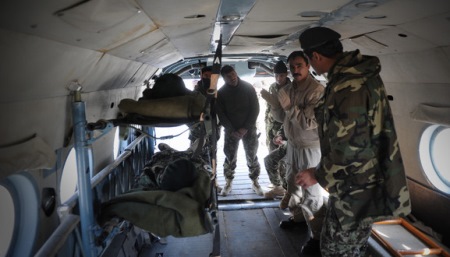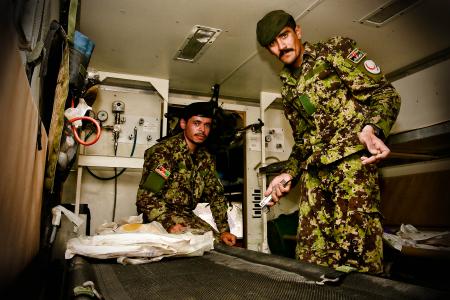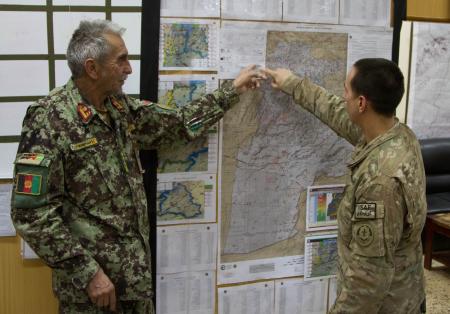|
Security Force Assistance |
|||
|
General Information
Books on Afghanistan
Blog Posts on
|
Afghan War News > SFA > SFA Medical in Afghanistan
Each Military Advisor Team (MAT) and Police Advisor Team (PAT) has a medic to provide medical coverage for the advisor team. In some cases, the medic works with an Afghan counterpart to improve the medical processes of their respective ANSF element.
ANSF Ground Medical Evacuation. The Afghan ground ambulance process is getting slowly better over time; but it still is not where it needs to be. The ability of the ANSF to ground evac its casualties varies from unit to unit and region to region. Some locations of ANA companies or AUP district centers are in remote or very dangerous areas. ANSF Air Medical Evacuation. The ANSF MEDEVAC process is currently broke although some helicopters are flying in some regions. The Afghan Air Force still has a long way to go before it can claim an adequate MEDEVAC or CASEVAC capability. Once in a while the Afghans pull off a medical evacuation successfully and in a timely manner; and ISAF is quick to point to that success in their IO campaign (see the "cheerleader" news reports provided by ISAF at the bottom of this page) - but the bottom line is the Afghans still don't have a sufficient air evac capability for their severely wounded in remote and dangerous areas. 4.
C-208 Cessna Caravan for Medical Transportation. One encouraging sign of progress is the use of C-208 Cessna Caravans for transporting wounded to hospitals. The process is that the ANA (or ANP) would transport a wounded or injured person to a fixed wing runway by ground evac. The the patient would be loaded onto the C-208 and flown to a medical facility (hopefully a hospital) for further medical treatment. 5. Importance of Air Medical Evacuation Capability. The willingness of many American Soldiers to fight 'outside the wire' in Afghanistan has a lot to do with the knowledge that they will be quickly MEDEVAC'd within the 'Golden Hour' and rushed to the appropriate level of medical care. The Afghan Soldiers are no different - for ten years they have also benefited from U.S. MEDEVACs. But with the drawing down of ISAF assets (to include MEDEVACs) and the U.S. posture on not providing MEDEVACs to the Afghans that willingness on the part of Afghan Soldiers may diminish. 3. "Just Say No". For the most part, ISAF has stopped providing MEDEVAC coverage to the ANA and ANP. This has caused some rapport problems with SFAATs and SFODAs advising and assisting their ANSF counterparts. See a related story entitled "Without US helicopters, Afghans struggle to save the wounded", Stars and Stripes, May 20, 2013 at this link.
Photo Above. An Afghan Border
Police (ABP) member is put on US MEDEVAC chopper in July 2013 in Spin
Boldac, Afghanistan. The US has limited the number of MEDEVACs flown for
the Afghan National Security Forces (ANSF), only flying occasionally for
the Afghans, which has severly impacted their morale and operational
effectiveness in some of the more remote and dangerous areas of
Afghanistan. Definations of MEDEVAC and CASEVAC? So what is the difference between a MEDEVAC and a CASEVAC? A MEDEVAC provides medical care enroute to a treatment facility while a CASEVAC (an aircraft not dedicated to medical evacuation) gets the patient to his first medical treatment. For more on the difference see "The Difference between MEDEVAC & CASEVAC: Video Update", War on Terror News, December 13, 2011 posted here. Currently the Afghans have a very limited CASEVAC capability but eventually (we hope) they will develop a MEDEVAC capability (see news article dated May 21, 2013 below).
Dental Training. Some dental professionals within the U.S. military are taking concrete steps to enhance the dental knowledge of ANA medical personnel. Some units provide training consisting of didactic courses 1. on dental anatomy, oral hygiene instruction, how to do dental exams, and the procedure for doing oral extractions. Challenges for Afghan Medical Providers. In addition to the problem areas identified above (lack of an Afghan MEDEVAC capability, unwillingness of the U.S. to provide helicopter evacuation, rudimentary medical training, lack of medical evacuation capability for remote and dangerous areas) there are other challenges as well. Dangers of Ground Evacuation. The primary means of providing medical care to wounded or injured ANSF members is by ground evacuation. Sometimes this is conducted by ambulance and sometimes it is in the back of a Ford Ranger pickup. Traveling the roads exposes the wounded and those caring and transporting them to small arms fire and IEDs. Additionally, some patients will die of their injuries by "bleeding out" due to the length of time required for ground evacuation.
Acquisition Process for Medical Supplies. Afghans are used to the 'push' system of logisitics and not used to the 'pull' system instituted by the U.S. military. As Americans provide less and less medical supply support ("Just say NO") the Afghans are hard pressed to provide basic medical supplies to their medical personnel due to a "broke" medical logistical system. Integration of ANA Medical Care with Other ANSF - or Not. There is a " . . . lack of synchonization between the Afghan Local Police, Afghan Border Police, National Directorate of Security and the ANA Medical team . . . ". 2. The ANA has an adequate medical system - when it is compared to the ANP, ALP, NDS and other ANSF elements but it doesn't necessarily provide this care to other ANSF elements. A part of the functional SFA model that is being adopted by ISAF will be the refinement of the Afghan medical evacuation and care system. ANSF Coordination of CASEVACss Through OCC-Rs. There is some progress being made in the coordination of medical evacuations through the offices of the Operational Coordination Centers or OCCs found at the regional level. The OCC-Rs are usually co-located with the ANA Corps HQs (or at least close by). Ultimately the end result of training with the OCC-Rs by medical advisors is to see simplified battle drills and established processes for CASEVACs (and in the future MEDEVACs), tracking on the SITMAP, and tracking of the seven line requests. 6.
September 8, 2015. Medical Care in Armed
Conflict: International Humanitarian Law and State Responses to Terrorism,
Harvard Law School. May 19, 2014. U.S. Military and Coalition
Efforts to Develop Effective and Sustainable Healthcare in Support of the
Afghan National Police, Inspector General DoD Report No.
DODIG-2014-072. February 2014. "HELISAF: Spanish SAR in
Afghanistan", airforcemonthly.com. A detailed and descriptive article on
the Spanish MEDEVAC crews who worked in RC-West by Erwan de Cherisey.
Posted on the Spanish Ministry of Defense website.
Health and Medical Topics - Afghanistan
May 13, 2014. "Special Operations medics learn new
skills". NATO.
September 30, 2015. "Golden Hour policy saved U.S. lives in Afghanistan". Military Times. September 10, 2015. "CASEVAC training gives confidence to Afghan forces". RS News. May 19, 2015. "The Heartbreaking Story Behind the Dustoff 7-3 Rescues in Afghanistan". By Erik Sabiston, Task & Purpose. January 28, 2015. "Afghan Air Force medics teach lifesaving skills to ANA troops". RS News. Story on how ANA are taught MEDEVAC procedures for the Mi-17 and C-208. January 5, 2015. "The Flying Hospital That Rushes Wounded Soldiers to Safety". Danger Room by Wired.com. Story on the C-17 Globemaster III MEDEVAC. November 29, 2014. "WHO and the Government of Japan sign a partnership programme to combat tuberculosis in Afghanistan". World Health Organization. November 28, 2014. "With fewer coalition troops in Afghanistan, 82nd medics running at a slower pace". Fayetteville Observer. November 27, 2014. "Brave Rifles medical officer ensures Afghan medical facilities are sustainable". DVIDS. Med doc explains the concept of "fly to advise". November 5, 2014. "Special Report: Left to fight alone, Afghanistan battles to save wounded". Reuters. September 19, 2014. "Are U.S. Soldiers Dying from Survivable Wounds?", The Wall Street Journal. A team of medical specialist review autopsies from Dover. May 24, 2014. "Afghan security forces poorly equipped to treat wounded: Pentagon". Latest warning about American pullout from Afghanistan. The Washington Times. DoD IG report cites inadequate medical training, supplies, and equipment for ANA. March 26, 2014. "Army medevac crew conducts training exercise in Afghanistan". Marines.mil. Medevacs rehearsed at FOB Delaram II. March 12, 2014. "Medical retrosort teams partner with regional commands to assist US forces, Afghans". DVIDS. 418th Medical Logistics company sort through and re-mission medical equipment and supplies; with some items passed on to Afghans through the Foreign Excess Personal Property Program. March 11, 2014. "Casualty notification process emphasizes dignity, respect". Army.mil. The U.S. Army's notification process has become more refined over the years. March 6, 2014. "Cross border movements threaten Afghan polio eradication efforts". IRIN (United Nations). March 5, 2014. "Ambitious U.S. hospital project in Afghanistan faces failure". Reuters. A $60 million project by USAID started in 2008 remains unfinished. March 5, 2014. "The last casualties: As a long war ends, risks still prove real". The Washington Post. An extensive, indepth look of the MEDEVAC process from point-of-injury on the battlefield to release from the hospital in the states. January 25, 2014. "Life saving money". DVIDS. Members of the 1st Theater Sustainment Command rescue expensive medical equipment and supplies from the retrosort yards at Bagram and Kandahar and pass off to USAID and the ANSF. January 24, 2014. "Medical training helps empower Afghan National Security Forces". DVIDS. Medic courses take place at the Kandahar Regional Military Hospital. January 10, 2014. "Spartans foster medical partnership with Afghan counterparts". DVIDS. Advisers with 3rd Brigade Combat Team, 10th Mountain Division provides the ANA with mentorship and support in the medical area. January 1, 2014. "Turning border police into lifesavers in Afghanistan's remotest places". Stars and Stripes. This news article talks about the improvements the Afghan Border Police (ABP) have made in medical care on the frontlines with the assistance of SFAATs; but also identifies deficiencies in training and medical supplies that still need to be corrected. December 9, 2013. "US medevac crews still play a major role in Afghan conflict". Stars and Stripes. Article describes the importance of the US medevac capability provided to the ANSF. November 2, 2013. "Battlefield Care: The development of the Afghan National Army's medics in Helmand". DVIDS. November 1, 2103. "Afghan ER: Helmand-based ANA supplied, training for life-saving capabilities". DVIDS. ANA receives transfer of large supply of medical materials. October 19, 2013. "KRMH continues success after ISAF transition". DVIDS. Kandahar Regional Medical Hospital has improved over the years. October 6, 2013. "As Afghan Troops Take the Lead, They Take More Casualties". WBUR, National Public Radio. September 3, 2013. "Assistance team teaches medical fundamentals to new Afghan National Army unit". Army.mil. Mobile Strike Force medics learn new skills. September 2, 2013. "Afghan National Army medics make major improvements to brigade aid station in Sangin". DVIDS. Medic station at FOB Nolay has improved. August 23, 2013. "Dedicated ANA Medics". DVIDS. Story is about medics in an ANA brigade - their state of training and scope of their job. August 8, 2103. "Afghan Medevacs Run to Gunfire, Explosions to Rescue Injured Comrades". U.S. News & Work Report. Story on U.S. MEDEVACs at Bagram. July 25, 2013. "ANA commandos receive dental training". DVIDS. 4th BCT, 101st Airborne Division dentists provide training to ANA. June 27, 2013. "US medics provide airway management training to ANA soldiers". DVIDS. 703rd BSB, 4th Inf BCT, 3rd Inf Div, Logar Province. June 16, 2013. "Afghan soldiers graduate from Combat Lifesavers Course". DVIDS. Members of the Afghan 203rd Corps Engineer Kandak (CEK) completed a 5-day CLS course at FOB Thunder - advised by the CEK SFAAT. June 12, 2013. "ANA medics take lead on first response". DVIDS. ANA medics in Paktika province are getting better according to Green 3 SFAAT, 2/10th Mountain. June 7, 2013. "ANA taking greater control of military healthcare". DVIDS. ANA now in control of Paktia Regional Military Hospital (PRMH). June 4, 2013. "White House scaling back military support for Afghan forces". USA Today. The author provides background as to why the US has discontinued MEDEVACs for ANSF. June 4, 2013. "US medical advisers help ANA improve medical capabilities". DVIDS. Article highlights CPT Esmerelda Linan - an adviser to an ANA COL who is the 201st Corps Surgeon. June 3, 2013. "A Dire Warning on Afghan Air Support". Commentary Magazine. June 2, 2013. "The Afghans Need American Air Support". The Wall Street Journal. Author calls for ISAF MEDEVACs for ANSF to continue - citing morale and fighting effectiveness as issues of concern. June 1, 2013. "Fort Campbell Security Force Advise and Assist Soldiers advise Afghan National Security Forces". Clarksville Online. SFAAT 11 of the 101st provides advise. May 24, 2013. "Afghan air force improves casualty evacuation capability". USAF. News release states that the Afghans have "rapidly risen to the challenge of improving casualty evacuation" by using Mi-17 Helicopters and Cessna 208 aircraft. Sure, okay . . . "rapidly?" . . . if you say so. May 24, 2013. "CASEVAC capability spreads through AAF". NTM-A. May 23, 2013. "Afghans Must Find Their Own Military Solutions". The Washington Post opinion page. The writer, a Navy Captain (O6), states that Afghans should do their own MEDEVACs instead of flying Afghan generals and VIPs around the countryside. Works for him - as that is the "party line"; but if he is an Army Captain (O3) on an SFAAT or SFODA how does he rebuild rapport after an Afghan Soldier bleeds out while US helicopters were buzzing about overhead? May 23, 2013. "Albanian medical mentorship team works to improve Afghan capabilities". NTM-A. May 21, 2013. "Don't Neglect Afghan Air Support". Commentary Magazine. Max Boot makes the argument that ISF should continue to provide US air support "enablers" - the most important being a air evacuation capability for casualties. May 21, 2013. "First Afghan flight medic class graduates". NTM-A. May 20, 2013. "Without U.S. helicopters, Afghans struggle to save wounded". The Washington Post. May 19, 2013. "Why We Serve: Afghan biomed tech wants best for ANA military medicine". NTM-A. May 14, 2013. "Medical Matters". Regional Command East. News article about medical personnel deployed as part of the 1/10 Security Forces Assistance Brigade. March 27, 2009. "Medical Evacuation exercise prepares crew for busy summer". DVIDS.
---------------------------------------------------------
1. For an example of a dental training program read "ANA Commandos receive dental training", The Leaf Chronicle, July 24, 2013. The news story is about dental training provided in Paktya province at Forward Operating Base Thunder. 2. See an August 8, 2013 DVIDS report entitled "Afghan medical providers increasing care" found here. 3. For more on a soldiers willingness to fight knowing the availability of MEDEVACs see "Combat Medical Evacuations Key to Afghanistan Success", U.S. News & World Report, June 21, 2013 posted here. 4. Read more on the challenges to coordinating and providing a CASEVAC to wounded or injured ANSF in remote mountainous areas of northeast Afghanistan within the 201st Corps area here. 5. For more on the use of the C-208 Cessna Caravan for medical evacuation see "Airmen help build Afghan air force: Focus is moving wounded troops to hospital", Air Force Times, September 8, 2013. Story is available here. 6. See "Medical operations in Afghanistan: Continued success as ANSF takes the lead", DVIDS, January 11, 2014. The news release provides information about how the RC South OCC-R is improving in their ability to track and coordinate CASEVACs using ANSF medical assets. Read story here.
All external sites open up in an new window. Please report any broken links or inaccuracies in content to the webmaster at staff@afghanwarnews.info.
|
||





